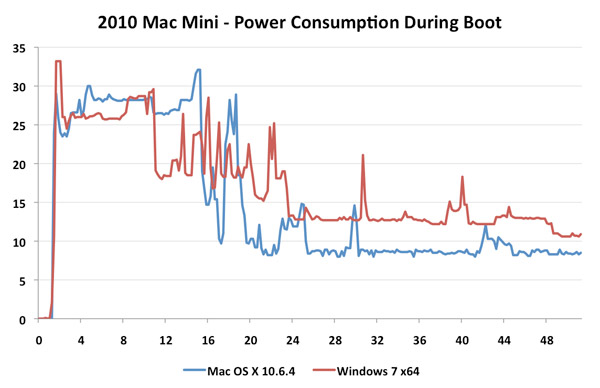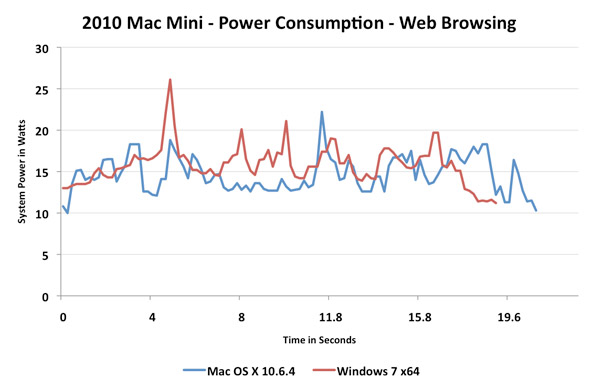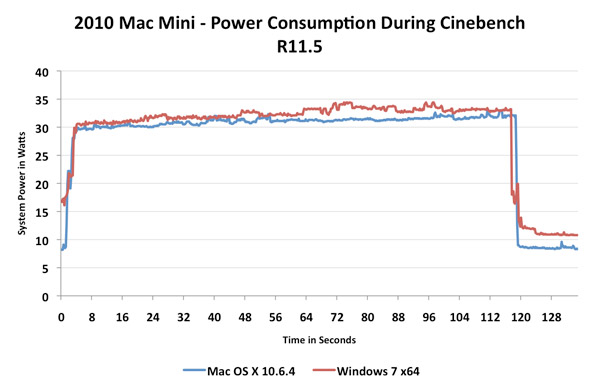Apple Mac mini Review (Mid 2010)
by Anand Lal Shimpi on August 9, 2010 3:37 AM ESTHonest Apple & Energy Efficiency
Apple calls the new Mac mini the world’s most energy-efficient desktop computer. I thought that might be a bit of a stretch but if you look at the numbers, they’re very convincing.
Zotac’s HD-ID11, an Atom based next-generation ION nettop, idles at 21.7W. Even the ASUS UL50V notebook, with a Core 2 Duo SU7300 (1.3GHz) ultra low voltage notebook CPU idles at 8.1W with the screen disabled.
Now that 8.1W number is unrealistic for a notebook. The screen was disabled, battery removed, WiFi disconnected and no ethernet cables plugged in. If I run the 2010 Mac mini in a similar configuration (minus the display/battery part since, well, they don’t exist), the entire system consumes 7.5W at idle.
Connect to a WiFi network, plug in an Ethernet cable and you’re looking at 8W. I have not seen a modern desktop machine idle at lower power than the 2010 Mac mini.
| 2010 Mac mini Power Usage | ||||||||
| Idle | Half Life 2 Episode Two | DVD Playback | Web Browsing | Quicktime Encode | Cinebench R11.5 | |||
| Apple Mac mini (Mid 2010) | 8.0W | 26.4W | 16.1W | 8.6W - 19W | 30.3W | 30.0W | ||
Part of this has to do with Apple’s very efficient integrated PSU. Unlike the other two systems I mentioned here, the mini uses a custom, integrated 85W PSU specifically designed for the system’s load.
Part of it has to do with Apple’s component selection. The mini is built entirely out of notebook parts with a custom motherboard design devoid of anything unnecessary. I’ve even heard that Apple goes to great lengths to ensure the CPUs/GPUs/chipsets it gets are on the lower power portion of the yield curve for products like the mini or MacBook Air.
The third explanation for why Apple is able to make such a bold claim about the Mac mini’s power consumption has nothing to do with hardware at all. As we’ve shown in the past, Mac OS X tends to offer better battery life than Windows in situations where the system sees a lot of idle time. Reading web pages, typing a document, etc... all tend to expose this advantage. Under load however, the OS X power advantage disappears - we are after all dealing with the same components regardless of OS.
The idle battery life advantage comes from lower idle power, presumably through heavy OS and hardware optimization. While I measured 8W at idle under OS X, running Windows 7 (power saver mode) on the Mac mini resulted in a 12W idle power without any changes to the hardware. Granted I don’t have identical hardware by another manufacturer to confirm that this isn’t negligence on Apple’s part to optimize its firmware for Windows 7. However in the past we’ve shown that systems from Lenovo, despite having similar specifications to Apple notebooks deliver worse idle battery life. I believe it’s safe to assume that part of the reason Apple is able to make such a bold claim about the mini’s energy efficiency is because it is the only desktop that can be sold running Mac OS X.
I recorded the mini’s power consumption over time running both OS X 10.6.4 and Windows 7 x64 to give you an idea of where the power consumption differences come into play.
This first chart shows power consumption during the boot process. From power on until you get a cursor at the desktop and the system’s power draw stabilizes for a while. The red line is Windows 7, the blue line is OS X:

Peak power consumption is nearly identical between the two OSes during the boot process. However, OS X drops down to idle sooner (finishes booting quicker) and remains at a lower idle point than Windows 7. Both OSes experience blips of activity after we reach the desktop as additional services are started.
The next test is some basic web browsing using Chrome. I loaded the AnandTech front page, scrolled to an article, clicked on it, scrolled down to the comments and recorded system power consumption:

I tried to get both runs as close as possible to one another, but I am human. Even while browsing the web the CPU has ample time to go into lower power states. Total platform power dips lower under OS X and is lower overall.
Our final test shows a run of Cinebench R11.5. The legend is the same, red for Windows, blue for OS X, but this time the CPU is pegged at 100% for the duration of the test:

The two systems are nearly identical in terms of power consumption. OS X still offers a slight advantage that’s consistent but not pronounced. The render completes in approximately the same amount of time in both OSes, although Windows is a hair quicker. The mini under OS X scored 1.38 points vs. 1.39 under Windows 7.
Since there is a performance difference here, it could just be that Apple is optimizing for power consumption rather than peak performance in the OS itself. It’s difficult to analyze but it’s something I am seeing fairly consistently.










93 Comments
View All Comments
Casper42 - Monday, August 9, 2010 - link
I know you said you already sent it back, but I'm curious why you didn't toss in an 80GB Intel G2 SSD (or a SandForce as mentioned), upgrade the RAM to 4GB and run it through all the paces again?Sure it comes out to be a $1000 machine at that point, but it would have been nice to see what the total potential of the platform would be. And putting in the SSD would arguably reduce the power footprint slightly as well.
akatsuki - Monday, August 9, 2010 - link
I think Apple's SSD support is still a bit thin anyway. Once they add TRIM support, etc. I think it will be a much better time to benchmark.I can't imagine spending that kind of money on a Mini over an entry level Macbook or a dedicated HTPC device - especially since GoogleTV and AppleTV revisions are due soon and should revitalize that area.
cjs150 - Tuesday, August 10, 2010 - link
Would have hit reply but for some reason locks my machine upNo way would I use this as a server. Far better is to pick up an Atom board with a PCI-E slot (for a nice raid card), 4gb of memory and use Ebox (free) as the server software. Would cost 50% of the Mac mini price.
Having just built one for a home server it is simply and just works without fuss
thunng8 - Tuesday, August 10, 2010 - link
Some nice nostalgia with the Powermac G5 2.5Ghz. I enjoyed reading about it. I'm surprised at how well it holds up in the benchmarks. Just a minor nitpick, but the Dual 2.5Ghz model was released in mid-2004, not early 2005.aliasfox - Tuesday, August 10, 2010 - link
Agreed - would love to have seen some "vintage" games, just to see if an ancient midrange graphics card can hack it against a modern integrated chip. Throwing in an old Northwood (or was it Prescott by the end of 2004?) system just for comparison's sake would be amusing, too.Ancient's relative, too - I'm running (and occasionally gaming!) on an 8-yr old Power Mac (with a Radeon 9700pro) and do "general" stuff on a PowerBook that's nearly as old...
I think one of the reasons that Power Mac G5s hold their value so well is that they are the only machines (pre Mac Pro) that could hold multiple HDs internally, as well as be upgraded (for a price) to a relatively modern GPU - ATI 3xxxx series, nVidia 8xxxx series, I think.
As for the mini... as much as I like Apple's products, I can't get behind the pricing of the Mac mini - sure, it's a great piece of industrial design, and I'd love to have a stylish, small, nearly-silent box in my home theater set up, but having to drop $800 before getting 4GB of RAM means this is far, far out of its price range. $499-599, maybe $699 with BD and 4GB of RAM... too bad Apple doesn't believe in BD. Or RAM. Or internal 3.5" HDs...
_gescom_ - Tuesday, August 10, 2010 - link
Great machine, but definitely way too expensive at 760+ EUR.It should cost 450/500 EUR like the old one.
Why additional 250+ EUR? I know, we sheep, you bleep.
Setsunayaki - Tuesday, August 10, 2010 - link
This is actually worse than a Laptop in a many ways...The scope of computers have changed and the public has proven the majority of people view email, write papers, use internet....or listen to music. Very basic things...
I find that netbooks are way better...considering you can buy an always-on internet connection with them and their battery life is good. When one looks at basic usage, i know people can talk about performance and other things out there....
But how many people out there who own computers as basic users end up using 30 - 40% of the processor on a dual core or quad core? I am still sitting here on a Quad Core and unless I am gaming or doing something heavy, I don't use it at heavy load. Once one eliminates the need for heavy servers or Heavy Gaming altogether...computers lose their grace..
I remember I bought a Laptop in 2005 for $300 on sale. I know by now every laptop outperforms mine, but I don't do 3D gaming on the laptop and I run on Ubuntu Linux. I am not even at the point where my processor chokes and most of the time I don't even use 2GB of RAM on the laptop.
Sorry, but with so many better offerings which include a monitor, keyboard and built in mouse along with portability, this MAC-Mini would have been great 4 years ago, unfortunately too little, too late.
hummerchine - Tuesday, August 10, 2010 - link
Man, you guys are a tough bunch to please! I own over 20 computers right now, from a gaming PC me and my son built with top shelf parts, to 5 Dell PCs, to a Mac Pro running a 30 inch monitor, to my wonderful new MacBook Pro 17", to three Mac Minis (not the latest...and best...ones), and multiple other Macs and PCs. Jeez, for many uses the Mac Mini totally rocks! And for many uses, it is the best computer you can possibly buy.I just cannot get over the seething hatred of Apple I sense so often...usually from people who hate them so much that they never use any of their products, and thus really know nothing about what they are talking about.
I have not used the very latest Mac Mini, but since it's better than the two new ones I bought earlier this year that are awesome I'd have to guess it's awesome too!
Rayb - Wednesday, August 11, 2010 - link
I see you really bought into their marketing hype, line, hook and sinker.An ION1 box fully loaded can do exactly the same things, including BD playback wireless and remote for around $200 less. Do you see the irony now?
With people like you thinking this is cutting edge tech in a new shinny box, I rest my case.
aliasfox - Wednesday, August 11, 2010 - link
I for one don't hate it - I hate the price.Even without i3 or i5, it's a great box - but at $700 (or near $850 with a basic monitor, keyboard, and mouse), it's far, far too expensive - in fact, the 'on the road' price is so close to a white macbook (with screen, keyboard, trackpad, and battery), that one has to imagine that Apple doesn't really *want* the mini to sell in huge numbers.